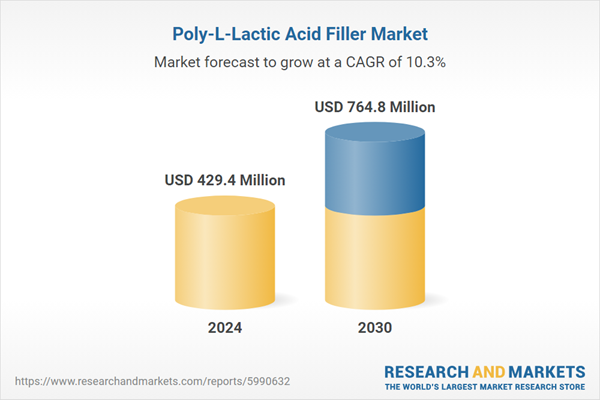The Poly-L-Lactic Acid Filler Market was valued at USD 429.4 million in 2024, and is projected to reach USD 764.8 million by 2030, rising at a CAGR of 10.30%. The primary factors driving the market growth are the rising demand for minimally invasive cosmetic procedures, the growing aging population, and technological advancements. According to the ASPS article published in September 2023, there has been a notable rise in the number of male patients pursuing minimally invasive cosmetic surgeries, with over 1.5 million men undergoing these procedures in 2022. This marks a 253 percent increase since 2019. These aspects fuel the growth of the market.
Moreover, technological advancements of poly-l-lactic acid (PLLA) filler is anticipated to boost the market growth. According to the NCBI article published in June 2022, initially approved for correcting nasolabial folds and other facial wrinkles, PLLA fillers are now also used off-label for body rejuvenation. This broader application highlights the flexibility of PLLA fillers, which can address various aesthetic issues beyond the face, such as volume loss, skin laxity, and wrinkles in different body areas, including the neck. A significant technological advancement of PLLA fillers is their capacity to stimulate collagen production, resulting in long-term aesthetic benefits. Research indicates an increase in collagen type-I at 3 and 6 months post-PLLA injections, establishing PLLA fillers as a distinct class of collagen stimulators with prolonged effects. This characteristic makes PLLA fillers popular for their ability to deliver lasting skin quality and volume improvements.
The growing adoption of PLLA fillers among healthcare professionals and patients fuels market growth. According to the NCBI article published in March 2024, scientific research has confirmed the effectiveness of PLLA fillers, which stimulate collagen production and are gradually broken down into carbon dioxide and water. Even after the PLLA fully degrades, the newly formed collagen fibers can continue to function for an extended period, highlighting the fillers' long-lasting benefits and safety.
This product will be delivered within 1-3 business days.
Moreover, technological advancements of poly-l-lactic acid (PLLA) filler is anticipated to boost the market growth. According to the NCBI article published in June 2022, initially approved for correcting nasolabial folds and other facial wrinkles, PLLA fillers are now also used off-label for body rejuvenation. This broader application highlights the flexibility of PLLA fillers, which can address various aesthetic issues beyond the face, such as volume loss, skin laxity, and wrinkles in different body areas, including the neck. A significant technological advancement of PLLA fillers is their capacity to stimulate collagen production, resulting in long-term aesthetic benefits. Research indicates an increase in collagen type-I at 3 and 6 months post-PLLA injections, establishing PLLA fillers as a distinct class of collagen stimulators with prolonged effects. This characteristic makes PLLA fillers popular for their ability to deliver lasting skin quality and volume improvements.
The growing adoption of PLLA fillers among healthcare professionals and patients fuels market growth. According to the NCBI article published in March 2024, scientific research has confirmed the effectiveness of PLLA fillers, which stimulate collagen production and are gradually broken down into carbon dioxide and water. Even after the PLLA fully degrades, the newly formed collagen fibers can continue to function for an extended period, highlighting the fillers' long-lasting benefits and safety.
Poly-L-lactic Acid Filler Market Report Highlights
- The face segment held the largest share of over 44.2% in 2024, owing to the rising popularity of facial rejuvenation procedures, technological advancements in fillers, and the expanding middle-aged and elderly population.
- The cosmetic surgery centers segment held the largest share of 44.9% in 2024, due to the presence of a higher number of these centers offering invasive procedures.
- North America dominated the global market with a revenue share of 36.51% in 2024, owing to advanced healthcare infrastructure, increasing adoption of aesthetic procedures, huge research and development activities, and continuous technological advancements in cosmetic treatments.
This report addresses:
- Market intelligence to enable effective decision-making.
- Market estimates and forecasts from 2018 to 2030.
- Growth opportunities and trend analyses.
- Segment and regional revenue forecasts for market assessment.
- Competition strategy and market share analysis.
- Product innovation listings for you to stay ahead of the curve.
- COVID-19's impact and how to sustain in this fast-evolving market.
Why Should You Buy This Report?
- Comprehensive Market Analysis: Gain detailed insights into the market across major regions and segments.
- Competitive Landscape: Explore the market presence of key players.
- Future Trends: Discover the pivotal trends and drivers shaping the future of the market.
- Actionable Recommendations: Utilize insights to uncover new revenue streams and guide strategic business decisions.
This product will be delivered within 1-3 business days.
Table of Contents
Chapter 1. Methodology and Scope
Chapter 2. Executive Summary
Chapter 3. Global Poly-L-lactic Acid (PLLA) Filler Market Variables, Trends & Scope
Chapter 4. Poly-L-lactic Acid (PLLA) Filler Market: Application Estimates & Trend Analysis
Chapter 5. Poly-L-lactic Acid (PLLA) Filler Market: End-use Estimates & Trend Analysis
Chapter 6. Poly-L-lactic Acid (PLLA) Filler Market: Regional Estimates & Trend Analysis by Country, Application, and End-use
Chapter 7. Competitive Landscape
List of Tables
List of Figures
Companies Mentioned
The major companies profiled in this Poly-L-Lactic Acid Filler market report include:- Galderma
- GANA R&D
- Sinclair Pharma
- PRP Science
- EPRUI Biotech
- Hyamax
Methodology

LOADING...
Table Information
| Report Attribute | Details |
|---|---|
| No. of Pages | 100 |
| Published | February 2025 |
| Forecast Period | 2024 - 2030 |
| Estimated Market Value ( USD | $ 429.4 Million |
| Forecasted Market Value ( USD | $ 764.8 Million |
| Compound Annual Growth Rate | 10.3% |
| Regions Covered | Global |
| No. of Companies Mentioned | 7 |









